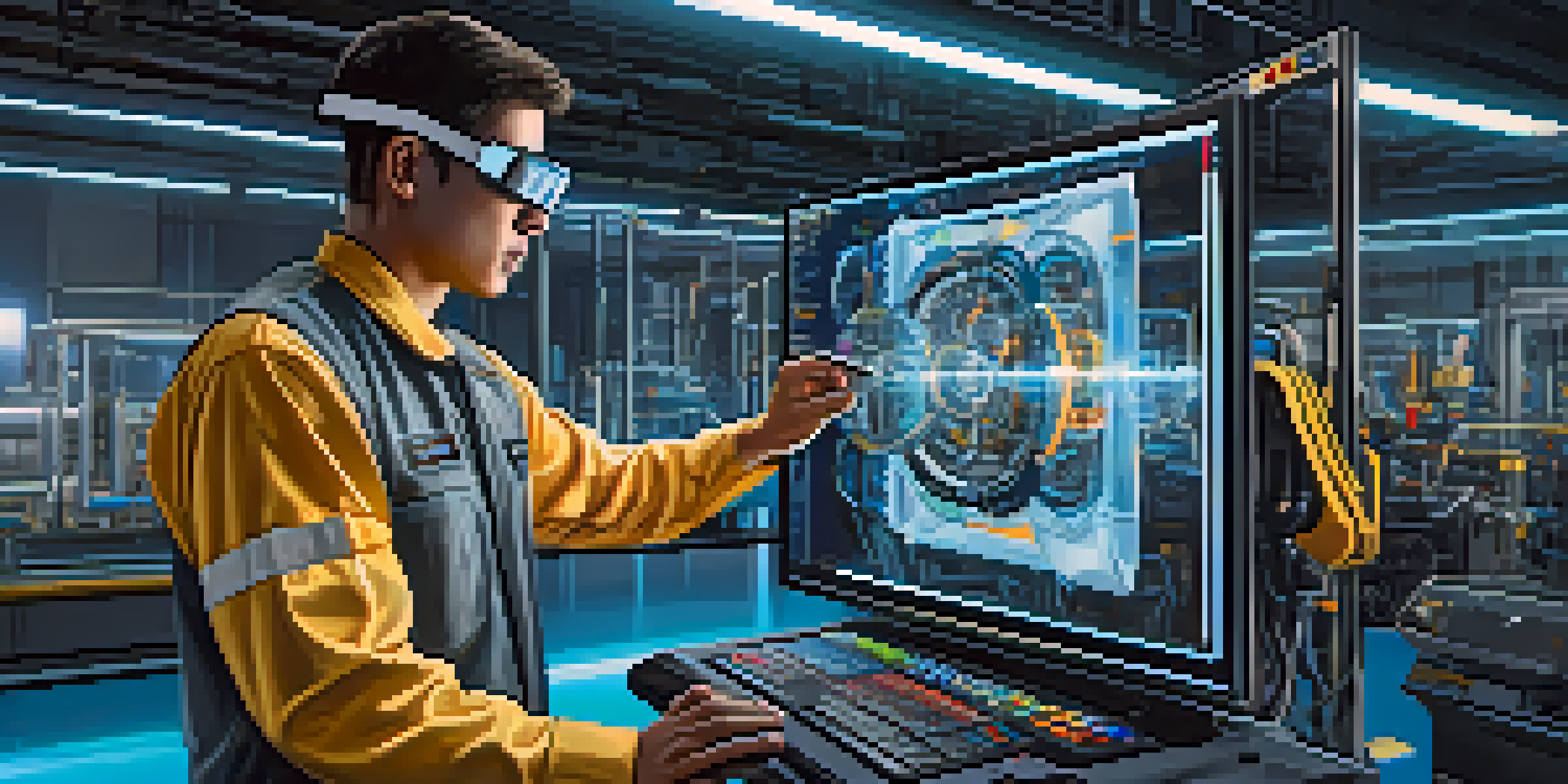The Intersection of Digital Twins and Augmented Reality

Understanding Digital Twins: A Quick Overview
Digital twins are virtual replicas of physical entities, capturing their characteristics, behaviors, and conditions in real time. Imagine having a detailed model of a car that mirrors every performance aspect, from engine temperature to fuel efficiency. This technology allows businesses to simulate scenarios and predict outcomes, enhancing decision-making processes.
Digital twins are a reflection of the physical world, providing insights that drive innovation and efficiency.
For example, in manufacturing, a digital twin can help monitor production lines, identifying bottlenecks before they occur. By analyzing data from the twin, companies can optimize their operations, leading to reduced costs and increased efficiency. It's a game-changer for industries that rely on precision and adaptability.
In essence, digital twins create a bridge between the physical and digital worlds, offering invaluable insights that drive innovation and improvement. As more sectors recognize their potential, the integration of digital twins into business strategies becomes increasingly vital for staying competitive.
Augmented Reality: Bridging the Gap Between Worlds
Augmented Reality (AR) enhances our perception of the real world by overlaying digital information onto physical spaces. Think of using your smartphone to see furniture in your living room before buying it—this is AR at work. By providing contextual information, AR enriches our interactions and decision-making processes.

In sectors like retail and education, AR offers immersive experiences that engage users in unique ways. For instance, students can visualize complex scientific concepts through 3D models, making learning not just informative but also interactive and fun. This level of engagement can enhance retention and understanding.
Digital Twins Enhance Decision-Making
Digital twins provide real-time insights that allow businesses to simulate scenarios and optimize operations.
Ultimately, AR serves as a powerful tool to enhance our everyday experiences, transforming how we interact with the world around us. As technology advances, the applications of AR continue to expand, promising even more innovative uses across various industries.
The Synergy: How Digital Twins and AR Work Together
The integration of digital twins and augmented reality creates a powerful synergy that enhances operational efficiency and user experience. Imagine a technician using AR glasses to visualize a digital twin of a machine while performing maintenance. This setup provides real-time data and insights directly in their field of view, making complex tasks simpler.
Augmented reality is the bridge that connects the digital and physical worlds, enriching our experiences and interactions.
Moreover, this combination allows for remote collaboration, where experts can assist on-site personnel by viewing the digital twin and overlaying relevant information in AR. This not only speeds up problem-solving but also reduces downtime, a critical factor in industries like manufacturing and energy.
Together, digital twins and AR create a dynamic environment where physical and digital realities merge. This fusion supports informed decision-making and fosters a proactive approach to maintenance and operations, ultimately driving innovation and growth.
Real-World Applications of Digital Twins and AR
Various industries are already benefiting from the combination of digital twins and augmented reality. In healthcare, for instance, surgeons can use AR to visualize a patient's digital twin during operations, providing critical insights that enhance precision and outcomes. This innovative approach can lead to faster recoveries and better patient care.
In construction, teams can overlay digital twins of buildings onto physical sites, allowing for better visualization and planning. This not only improves communication among stakeholders but also helps identify potential issues before they arise, saving time and resources. The ability to foresee challenges is invaluable in complex projects.
AR Transforms User Interactions
Augmented reality enriches real-world experiences by overlaying digital information, enhancing engagement and understanding.
These examples demonstrate how digital twins and AR are revolutionizing industries by enhancing accuracy and efficiency. As more sectors adopt this technology, we can expect to see even more innovative solutions that address contemporary challenges.
Benefits of Combining Digital Twins and AR
The benefits of integrating digital twins and augmented reality are substantial, ranging from improved efficiency to enhanced user engagement. By visualizing complex data through AR, users can make better-informed decisions quickly. This capability is particularly crucial in fast-paced environments where time is of the essence.
Additionally, the combination allows for predictive maintenance, enabling companies to address potential failures before they occur. By analyzing the digital twin and using AR for visualization, businesses can save money and resources while minimizing downtime. This proactive approach is essential in maintaining operational continuity.
Furthermore, this integration fosters collaboration across teams, regardless of geographical locations. With AR, experts can guide field workers through complex processes, ensuring that tasks are completed accurately and efficiently. This level of collaboration enhances productivity and strengthens team dynamics.
Challenges in Implementing Digital Twins and AR
Despite the immense potential of digital twins and augmented reality, there are challenges to consider when implementing this technology. One significant hurdle is the initial investment in software and hardware, which can be substantial depending on the complexity of the project. Companies must weigh the costs against potential benefits to make informed choices.
Moreover, data security is a critical concern, particularly when dealing with sensitive information. Ensuring that digital twins are protected from cyber threats is vital to maintaining trust and integrity within the system. Companies must adopt robust security measures to safeguard their data while capitalizing on the benefits of these technologies.
Synergy Boosts Efficiency and Innovation
The combination of digital twins and AR facilitates collaboration and proactive maintenance, driving operational efficiency.
Finally, there can be a steep learning curve for employees as they adapt to new systems and processes. Proper training and support are essential to ensure a smooth transition and encourage adoption. By addressing these challenges proactively, organizations can leverage the full potential of digital twins and AR.
The Future of Digital Twins and Augmented Reality
The future of digital twins and augmented reality looks bright, with continuous advancements promising even more innovative applications. As technology evolves, we can expect greater integration between these two fields, leading to more seamless experiences and enhanced capabilities. Industries will likely discover new ways to harness this synergy to drive efficiency and innovation.
Additionally, as AR technology becomes more accessible, we may see increased adoption across various sectors, from manufacturing to healthcare. This democratization of technology could pave the way for smaller businesses to benefit from the same advantages as larger corporations, fostering a more competitive landscape.

Ultimately, the combination of digital twins and augmented reality is set to redefine how we interact with and understand our environments. By embracing these technologies, organizations can position themselves at the forefront of their industries, ready to tackle future challenges with confidence.